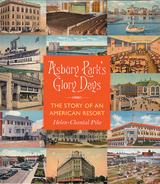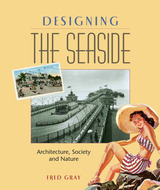5 books about Seaside resorts

Asbury Park's Glory Days
The Story of an American Resort
Pike, Helen-Chantal
Rutgers University Press, 2007
Long before Bruce Springsteen picked up a guitar; before Danny DeVito drove a taxi; before Jack Nicholson flew over the cuckoo's nest, Asbury Park was a seashore Shangri-La filled with shimmering odes to civic greatness, world-renowned baby parades, temples of retail, and atmospheric movie palaces. It was a magnet for tourists, a summer vacation mecca-to some degree New Jersey's own Coney Island.
In Asbury Park's Glory Days, award-winning author Helen-Chantal Pike chronicles the city's heyday-the ninety-year period between 1890 and 1980. Pike illuminates the historical conditions contributing to the town's cycle of booms and recessions. She investigates the factors that influenced these peaks, such as location, lodging, dining, nightlife, merchandising, and immigration, and how and why millions of people spent their leisure time within this one-square-mile boundary on the northern coast of the state. Pike also includes an epilogue describing recent attempts to resurrect this once-vibrant city.
In Asbury Park's Glory Days, award-winning author Helen-Chantal Pike chronicles the city's heyday-the ninety-year period between 1890 and 1980. Pike illuminates the historical conditions contributing to the town's cycle of booms and recessions. She investigates the factors that influenced these peaks, such as location, lodging, dining, nightlife, merchandising, and immigration, and how and why millions of people spent their leisure time within this one-square-mile boundary on the northern coast of the state. Pike also includes an epilogue describing recent attempts to resurrect this once-vibrant city.
[more]

By the Beautiful Sea
The Rise and High Times of That Great American Resort, Atlantic City
Funnell, Charles
Rutgers University Press, 1983
The Rise and High Times of That Great American Resort, Atlantic City
[more]

The Country of the Pointed Firs and Other Stories
Sarah Orne Jewett
University of New Hampshire Press, 1997
The Country of the Pointed Firs (1896) is Sarah Orne Jewett's most popular book. In its elegantly constructed sketches, a worldly, anonymous writer spends the summer in a tiny Maine fishing village where she hopes to find peace and solitude. As she gains the acceptance and trust of her hosts, the community's power and complexity are slowly revealed. While its episodes portray the difficulty and loneliness of rural life, they also display its dignity and strength, particularly as expressed in the bonds between women: mothers, daughters, and friends.
This centennial edition contains a facsimile of the original text, thereby restoring the novel to Jewett's own version, which had been considerably altered in other published versions, plus four related stories. Further enhancing the importance of this volume is editor Sarah Way Sherman's introduction, which includes a sketch of Jewett's life and professional development, a commentary on textual accuracy, and a discussion of the book's themes and techiques as well as its historical context.
This centennial edition contains a facsimile of the original text, thereby restoring the novel to Jewett's own version, which had been considerably altered in other published versions, plus four related stories. Further enhancing the importance of this volume is editor Sarah Way Sherman's introduction, which includes a sketch of Jewett's life and professional development, a commentary on textual accuracy, and a discussion of the book's themes and techiques as well as its historical context.
[more]

Designing the Seaside
Architecture, Society and Nature
Fred Gray
Reaktion Books, 2009
In Alfred Hitchcock’s To Catch a Thief, a seaside resort was the setting for thievery and intrigue. Fred Astaire and Ginger Rogers tap-danced their way to fame at a Brighton resort in The Gay Divorcee. The seaside resort has always held a special fascination, a place of containment and leisure that has a unique form in the physical landscape: towering hotels, shop-lined boardwalks, and sprawling beaches. Fred Gray delves into the history of seaside architecture here in Designing the Seaside, writing the rich and international story of the seaside resort’s diverse structures from the eighteenth century through today.
Gray is interested not only in the physical structures but also the cultural mores they represent—the “yearly holiday,” and our attitudes about leisure. The coastal landscape has been transformed by this geography of relaxation, and Gray considers the physical and cultural shifts that occurred when shops, boardwalks, and hotels buried sand dunes and marshes beneath their beams. He examines the design processes that went into creating the diverse buildings and spaces within a seaside resort, giving full attention to ephemeral structures such as pavilions and summer gift shops as well as the trademark hotel buildings, fairgrounds, and open spaces. Designing the Seaside also reveals how events such as beauty pageants made seaside resorts into sites of debate over conflicted issues of sexuality and morality.
Drawing on a diverse array of historical material—photographs, guidebooks, postcards, and posters—Fred Gray offers a fascinating account of the cultural and social symbolism of the seaside resort and its role in the modern landscape.
Gray is interested not only in the physical structures but also the cultural mores they represent—the “yearly holiday,” and our attitudes about leisure. The coastal landscape has been transformed by this geography of relaxation, and Gray considers the physical and cultural shifts that occurred when shops, boardwalks, and hotels buried sand dunes and marshes beneath their beams. He examines the design processes that went into creating the diverse buildings and spaces within a seaside resort, giving full attention to ephemeral structures such as pavilions and summer gift shops as well as the trademark hotel buildings, fairgrounds, and open spaces. Designing the Seaside also reveals how events such as beauty pageants made seaside resorts into sites of debate over conflicted issues of sexuality and morality.
Drawing on a diverse array of historical material—photographs, guidebooks, postcards, and posters—Fred Gray offers a fascinating account of the cultural and social symbolism of the seaside resort and its role in the modern landscape.
[more]

Queering Rehoboth Beach
Beyond the Boardwalk
James T. Sears
Temple University Press, 2024
“Create a More Positive Rehoboth” was a decades-long goal for progress and inclusiveness in a charming beach town in southern Delaware. Rehoboth, which was established in the 19th century as a Methodist Church meeting camp, has, over time, become a thriving mecca for the LGBTQ+ community. In Queering Rehoboth Beach, historian and educator James Sears charts this significant evolution.
Sears draws upon extensive oral history accounts, archival material, and personal narratives to chronicle “the Battle for Rehoboth,” which unfolded in the late 20th century, as conservative town leaders and homeowners opposed progressive entrepreneurs and gay activists. He recounts not just the emergence of the gay and lesbian bars, dance clubs, and organizations that drew the queer community to the region, but also the efforts of local politicians and homeowners, among other groups who fought to develop and protect the traditional identity of this beach town. Moreover, issues of race, class, and gender and sexuality informed opinions as residents and visitors struggled with the AIDS crisis and the legacy of Jim Crow.
Queering Rehoboth Beach is more than just an inspiring story about a community’s resilience and determination to establish a safe space for itself in the wake of the era of Don’t Ask, Don’t Tell. It is also a terrific beach read.
Sears draws upon extensive oral history accounts, archival material, and personal narratives to chronicle “the Battle for Rehoboth,” which unfolded in the late 20th century, as conservative town leaders and homeowners opposed progressive entrepreneurs and gay activists. He recounts not just the emergence of the gay and lesbian bars, dance clubs, and organizations that drew the queer community to the region, but also the efforts of local politicians and homeowners, among other groups who fought to develop and protect the traditional identity of this beach town. Moreover, issues of race, class, and gender and sexuality informed opinions as residents and visitors struggled with the AIDS crisis and the legacy of Jim Crow.
Queering Rehoboth Beach is more than just an inspiring story about a community’s resilience and determination to establish a safe space for itself in the wake of the era of Don’t Ask, Don’t Tell. It is also a terrific beach read.
[more]
READERS
Browse our collection.
PUBLISHERS
See BiblioVault's publisher services.
STUDENT SERVICES
Files for college accessibility offices.
UChicago Accessibility Resources
home | accessibility | search | about | contact us
BiblioVault ® 2001 - 2024
The University of Chicago Press









